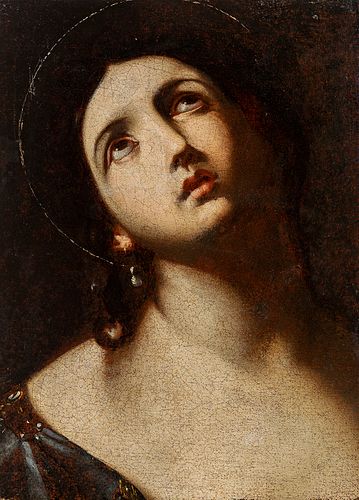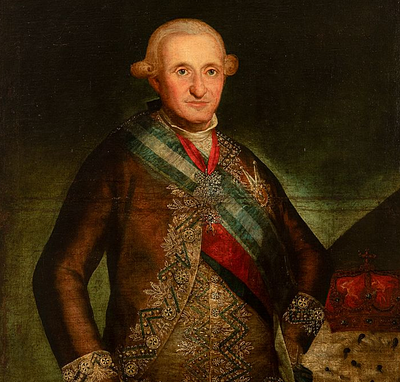Circle of GUIDO RENI (Calvenzano di Vergato, Bologna, 1575 - Bologna, 1642). "Saint". Oil on canvas. Relined
Lot 13
About Seller
Setdart Auction House
Carrer Aragó 346
Barcelona
Spain
Setdart Subastas was born in 2004 and is currently the first online art auction in Spain with solidity, prestige and reliability guaranteed by our more than 60,000 users. Setdart has a young, dynamic and enterprising team ready to successfully manage the purchase and sale of art works through custom...Read more
Estimate:
EUR€3,000 - EUR€3,500
$3,092.78 - $3,608.25
Absentee vs Live bid
Two ways to bid:
- Leave a max absentee bid and the platform will bid on your behalf up to your maximum bid during the live auction.
- Bid live during the auction and your bids will be submitted real-time to the auctioneer.
Bid Increments
| Price | Bid Increment |
|---|---|
| EUR€0 | EUR€10 |
| EUR€200 | EUR€25 |
| EUR€500 | EUR€50 |
| EUR€1,000 | EUR€100 |
| EUR€3,000 | EUR€200 |
| EUR€5,000 | EUR€500 |
| EUR€10,000 | EUR€1,000 |
| EUR€20,000 | EUR€2,000 |
| EUR€50,000 | EUR€5,000 |
About Auction
By Setdart Auction House
Sep 22, 2021
Set Reminder
2021-09-22 09:30:00
2021-09-22 09:30:00
America/New_York
Bidsquare
Bidsquare : 22nd September - ARAS JÁUREGUI Private Collection - Old Masters, 19th & 20th Century
https://www.bidsquare.com/auctions/setdart-auction-house/22nd-september---aras-j-uregui-private-collection---old-masters-19th-20th-century-7427
ARAS JÁUREGUI Private Collection - Old Masters, 19th & 20th Century Setdart Auction House sofia@setdart.com
ARAS JÁUREGUI Private Collection - Old Masters, 19th & 20th Century Setdart Auction House sofia@setdart.com
- Lot Description
Circle of GUIDO RENI (Calvenzano di Vergato, Bologna, 1575 - Bologna, 1642). "Saint". Oil on canvas. Relined It presents faults and repainting. Measurements: 47,5 x 34,5 cm. Female portrait of short bust, where the artist portrays in a monumental way the face of a saint, which is deduced by the halo that is placed next to her head. The work follows aesthetic models close to the work of Guido Reni, who produced portraits of similar subject matter on numerous occasions, with numerous female saints as the protagonists. Furthermore, in this work, we see the monumentalisation of the figure mentioned above, a soft treatment of the forms, with tight, fleshy lips, as well as a very effective light treatment, similar characteristics to the works of Guido Reni. Due to the lack of iconographic attributes, it is difficult to identify the saint, whose only singular characteristic is the presence of a pearl earring. The undisputed master of Roman-Bolognese classicism alongside Albani and Domenichino, Guido Reni was undoubtedly the best of the three. Closely linked to the Carracci family and to the city of Bologna, they all had a similar career. They trained in Bologna with Denys Calvaert, and then went to the Accademia degli Incamminati, directed by Ludovico Carraci. In 1600 Reni arrived in Rome, where he worked with Annibale Carracci in the Galleria Farnese. His best period began in these years; in 1609, on Annibale's death, Reni became the head of the classicist school. In the city he was the protégé of Scipione Borghese, the future Pope Paul V, for whom the painter produced one of his most important works, "La Aurora" (Palazzo Rospigliosi). It reveals something that would always be characteristic of Reni's style, his admiration for ancient sculpture. Starting from classical statues, he developed an ideal of beauty and perfection that would be greatly admired by subsequent painters. In 1614 he returned to Bologna for good. Reni's style evolved in a clear direction, becoming more and more sculptural and cold, more and more fully classicist. His mature work was characterised by a cold, silvery palette. Finally, from the 1930s onwards, his style became sketchy, with an unfinished appearance and a tendency towards monochrome, of great interest from a technical as well as a formal point of view. Today Guido Reni is represented in the most important art galleries all over the world, including the Prado Museum, the Hermitage, the Louvre, etc.
- Shipping Info
-
In-house shipping available. Please inquire at admin@setdart.com.
-
- Buyer's Premium



 EUR
EUR CAD
CAD AUD
AUD GBP
GBP MXN
MXN HKD
HKD CNY
CNY MYR
MYR SEK
SEK SGD
SGD CHF
CHF THB
THB















